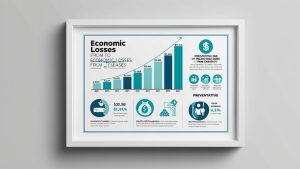Livestock and poultry farming contribute significantly to global food security and economic growth. However, diseases in livestock can cause substantial economic losses through decreased productivity, high treatment costs, and mortality. Preventive measures such as biosecurity, vaccination, and proper management practices are crucial in mitigating these losses.
This article explores the financial impact of animal diseases and provides effective prevention strategies to protect farmers’ investments and ensure sustainable production.
Click HERE to join our WhatsApp group chat
Understanding Economic Losses Due to Diseases
a) Direct Economic Losses
Mortality: Loss of animals due to fatal diseases directly affects farm revenue.
Reduced Productivity: Diseases lower milk yield, egg production, growth rates, and reproductive performance.
Treatment Costs: Expenses for veterinary services, medications, and supportive care increase operational costs.
Condemnation of Products: Infected animals may produce meat, milk, or eggs unsuitable for human consumption, leading to waste.
b) Indirect Economic Losses
Market Restrictions: Disease outbreaks can result in trade bans and reduced market access.
Increased Labor Costs: Sick animals require additional care, increasing labor demands.
Reduced Genetic Potential: Diseases affecting breeding stock lead to long-term productivity losses.
Environmental Costs: Some diseases require culling of infected animals, leading to waste disposal challenges.
READ ALSO: Zoonotic diseases in Livestock and Poultry
Major Diseases Causing Economic Losses

a) Viral Diseases
Foot-and-Mouth Disease (FMD): Causes severe production losses in cattle, pigs, and sheep.
Newcastle Disease: Affects poultry, leading to high mortality rates and reduced egg production.
African Swine Fever (ASF): Highly fatal in pigs, with no available vaccine, causing entire herd losses.
b) Bacterial Diseases
Mastitis: A costly disease in dairy cattle, reducing milk quality and yield.
Brucellosis: Affects reproductive performance, leading to abortions and infertility in livestock.
Colibacillosis: Common in young animals, leading to severe diarrhea, dehydration, and weight loss.
c) Parasitic Diseases
Coccidiosis: Affects poultry and ruminants, causing intestinal damage and poor feed conversion.
Trypanosomiasis: Also known as sleeping sickness, it affects cattle and reduces work efficiency and milk production.
Helminthiasis (Worm Infestation): Leads to reduced weight gain and productivity in various livestock species.
READ ALSO: Turkey Farming for Meat Production
Strategies to Prevent Economic Losses from Diseases
a) Biosecurity Measures
Restrict access to farms and enforce hygiene protocols.
Quarantine new animals before introduction to the herd.
Implement rodent and insect control to minimize disease transmission.
b) Vaccination Programs
Follow a structured vaccination schedule for common diseases.
Use high-quality vaccines from reputable manufacturers.
Educate farm workers on the importance of proper vaccination practices.
c) Proper Nutrition and Management
Provide balanced diets rich in essential nutrients to enhance immune response.
Ensure adequate housing and ventilation to prevent stress-related diseases.
Maintain clean water sources to reduce waterborne infections.
d) Regular Health Monitoring and Early Detection
Conduct routine veterinary check-ups and disease surveillance.
Train farm workers to recognize early disease symptoms.
Implement isolation protocols for infected animals to prevent disease spread.
e) Sustainable Disease Control Practices
Reduce antibiotic use to minimize antimicrobial resistance (AMR).
Promote natural disease resistance through selective breeding.
Integrate traditional and modern disease management strategies.
READ ALSO: Goat Farming for Meat and Milk Production
Economic Benefits of Disease Prevention
a) Higher Productivity and Profitability
Healthy animals grow faster, produce more, and yield higher-quality products.
Reduced veterinary costs and fewer losses improve farm profitability.
b) Improved Market Access and Trade Opportunities
Disease-free farms gain better access to export markets.
Compliance with food safety standards enhances consumer confidence.
c) Sustainable Farming and Environmental Benefits
Proper disease management reduces the need for culling, minimizing waste.
Lower use of antibiotics and chemicals supports sustainable farming practices.
Conclusion
Animal diseases pose significant economic threats to livestock and poultry farming. Implementing effective prevention measures, including biosecurity, vaccination, and proper management, can drastically reduce losses. By prioritizing disease prevention, farmers can ensure sustainable production, improve profitability, and enhance food security. Investing in preventive strategies is a cost-effective approach to protecting livestock and securing long-term success in the agricultural industry.
READ ALSO: Heat Stress in Poultry and Livestock: Causes, Effects, and Management
Heat stress is a major challenge in poultry and livestock production, especially in tropical and subtropical regions. Rising global temperatures, coupled with high humidity, can severely impact the health, productivity, and welfare of farm animals. Heat stress occurs when animals are unable to dissipate excessive heat from their bodies, leading to physiological and metabolic disturbances…
READ ALSO: Use of Antibiotics in Livestock and Poultry Nutrition
Antibiotics have played a significant role in modern livestock and poultry farming by promoting growth, preventing diseases, and improving overall animal health. However, the use of antibiotics in animal nutrition has sparked considerable debate due to concerns about antimicrobial resistance (AMR), food safety, and environmental impact…
Click HERE to join our WhatsApp group chat